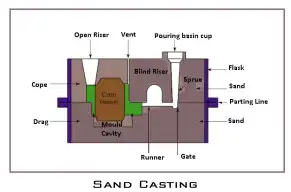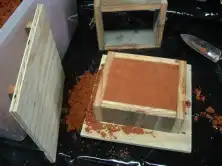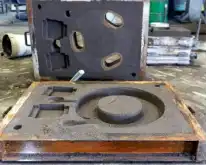
Knowledge
What is Sand Casting
Sand casting is a metal casting process characterized by using sand as the mold material. It is one of the oldest and most common casting methods and is particularly suitable for the production of complex shapes with a relatively low cost.
Process Steps:
- Pattern Making: A pattern is made of the object to be cast, which is a model or template of the final product. Patterns can be made from wood, metal, or plastic.
- Mold Preparation: The pattern is placed in a large container filled with sand, which is then compacted around the pattern. The sand is held together with a binder, which can be a chemical or a clay-based substance.
- Core Making: For castings with internal cavities, cores are made from the same sand mixture and placed into the mold before the metal is poured.
- Mold Assembly: Once the sand has set, the pattern is removed, leaving a cavity in the shape of the casting. The mold is then closed and secured, with gates and risers added to control the flow and feeding of the molten metal.
- Pouring: Molten metal is poured into the mold through a pouring basin or gating system. The metal fills the cavity, displacing the air and solidifying in the shape of the pattern.
- Cooling and Solidification: The metal cools and solidifies within the sand mold.
- Mold Breaking: Once the metal has solidified, the sand mold is broken apart, and the casting is removed.
- Finishing: The casting is then cleaned, and any excess material (runners, gates, risers) is removed. Additional machining or finishing may be done to achieve the desired dimensions and surface finish.

Key Features of Sand Casting:
- Material Flexibility: Sand casting can be used with a variety of metals, including iron, steel, aluminum, and bronze.
- Complex Shapes: It is well-suited for casting complex shapes that might be difficult to achieve with other casting methods.
- Cost-Effective: Sand casting is relatively inexpensive, especially for small to medium production runs, due to the low cost of sand and the ability to reuse patterns.
- Draft Allowance: Patterns must have a draft angle to facilitate their removal from the sand mold, which can influence the design of the casting.
- Surface Finish: The surface finish of sand castings is generally rougher compared to other casting methods like die casting, often requiring further machining or finishing.
- Size and Weight: Sand casting can produce ranging from small to very large, making it suitable for a wide range of applications.
- Environmental Considerations: Sand casting generates a significant amount of sand waste, which needs to be managed properly.
|
|
|
Sand casting is widely used in many industries, China vigor has a wealth of sand casting experience, Welcome to contact Vigor for more detailed information, call us at 029 81161513 or email us at info@castings-forging.com.





